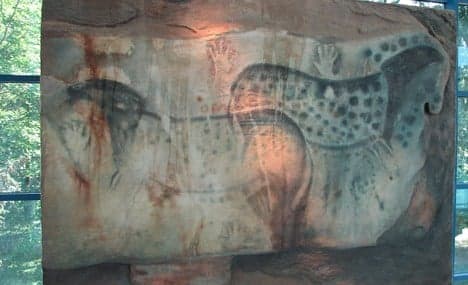Scientists: Cave-painting horses existed

An international team of researchers led by a German scientist believe they have found the first evidence that spotted horses, often depicted in cave paintings, actually existed tens of thousands of years ago.
That means ancient artists were drawing what they saw around them, and were
not abstract or symbolic painters – a topic of much debate among archaeologists – said the findings in the Proceedings of the National Academy of Sciences.
"We are just starting to have the genetic tools to access the appearance of past animals and there are still a lot of question marks and phenotypes for which the genetic process has not yet been described," said study leader Melanie Pruvost of the Leibniz Institute for Zoo and Wildlife Research and the Department of Natural Sciences at the German Archaeological Institute in Berlin.
"However, we can already see that this kind of study will greatly improve our knowledge about the past."
By analysing bones and teeth from more than 30 horses in Siberia and Europe dating back as many as 35,000 years, researchers found that six shared a gene associated with a type of leopard spotting seen in modern horses.
Until now, scientists only had DNA evidence of monochrome horses, such as bay and black.
One prominent example that has generated significant debate over its inspiration is the 25,000-year-old painting, "The Dappled Horses of Pech-Merle" in France, showing white horses with black spots.
"The spotted horses are featured in a frieze which includes hand outlines and abstract patterns of spots," saidTerry O'Connor, a professor at the University of York's Department of Archaeology.
"The juxtaposition of elements has raised the question of whether the spotted pattern is in some way symbolic or abstract, especially since many researchers considered a spotted coat phenotype unlikely for Palaeolithic horses," he said.
"However, our research removes the need for any symbolic explanation of the horses. People drew what they saw."
Scientists from Britain, Mexico, the United States, Spain and Russia helped with the genotyping and analysis of the results.
AFP/mdm
Comments
See Also
That means ancient artists were drawing what they saw around them, and were
not abstract or symbolic painters – a topic of much debate among archaeologists – said the findings in the Proceedings of the National Academy of Sciences.
"We are just starting to have the genetic tools to access the appearance of past animals and there are still a lot of question marks and phenotypes for which the genetic process has not yet been described," said study leader Melanie Pruvost of the Leibniz Institute for Zoo and Wildlife Research and the Department of Natural Sciences at the German Archaeological Institute in Berlin.
"However, we can already see that this kind of study will greatly improve our knowledge about the past."
By analysing bones and teeth from more than 30 horses in Siberia and Europe dating back as many as 35,000 years, researchers found that six shared a gene associated with a type of leopard spotting seen in modern horses.
Until now, scientists only had DNA evidence of monochrome horses, such as bay and black.
One prominent example that has generated significant debate over its inspiration is the 25,000-year-old painting, "The Dappled Horses of Pech-Merle" in France, showing white horses with black spots.
"The spotted horses are featured in a frieze which includes hand outlines and abstract patterns of spots," saidTerry O'Connor, a professor at the University of York's Department of Archaeology.
"The juxtaposition of elements has raised the question of whether the spotted pattern is in some way symbolic or abstract, especially since many researchers considered a spotted coat phenotype unlikely for Palaeolithic horses," he said.
"However, our research removes the need for any symbolic explanation of the horses. People drew what they saw."
Scientists from Britain, Mexico, the United States, Spain and Russia helped with the genotyping and analysis of the results.
AFP/mdm
Join the conversation in our comments section below. Share your own views and experience and if you have a question or suggestion for our journalists then email us at [email protected].
Please keep comments civil, constructive and on topic – and make sure to read our terms of use before getting involved.
Please log in here to leave a comment.